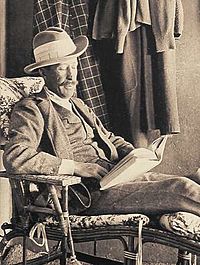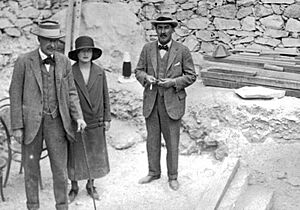George Herbert, 5th Earl of Carnarvon facts for kids
Quick facts for kids
The Earl of Carnarvon
DL
|
|
|---|---|

Lord Carnarvon, who was the chief financial backer on many of Howard Carter's Egyptian excavations.
|
|
| Born | George Edward Stanhope Molyneux Herbert 28 June 1866 66 Grosvenor Street, Mayfair, London, England |
| Died | 5 April 1923 (aged 56) Cairo, Kingdom of Egypt |
| Resting place | Beacon Hill, Burghclere, Hampshire |
| Title | 5th Earl of Carnarvon |
| Tenure | 29 June 1890 – 5 April 1923 |
| Other titles | Lord Porchester (until 1890) |
| Known for | Discovery of Tutankhamun’s tomb |
| Nationality | British |
| Residence | Highclere Castle |
| Spouse(s) |
Almina Wombwell
(m. 1895) |
| Issue |
|
| Parents |
|
|
|
|
George Edward Stanhope Molyneux Herbert, 5th Earl of Carnarvon (born June 26, 1866 – died April 5, 1923) was a British nobleman. He is best known for providing the money to search for and dig up Tutankhamun's tomb in the Valley of the Kings in Egypt. He was known as Lord Porchester until 1890.
Contents
Early Life and School
George Herbert was born in London, England. He was the only son of Henry Herbert, the 4th Earl of Carnarvon. His father was an important politician.
George went to Eton College and later to Trinity College, Cambridge. When his father passed away in 1890, George became the 5th Earl of Carnarvon.
Family Life
Lord Carnarvon married Almina Victoria Maria Alexandra Wombwell on June 26, 1895. Almina was the daughter of a very rich banker named Alfred de Rothschild. He gave them a large sum of money, which helped Lord Carnarvon pay off his debts.
Lord and Lady Carnarvon had two children:
- Henry George Herbert, who became the 6th Earl of Carnarvon.
- Lady Evelyn Leonora Almina Herbert.
Love for Horse Racing
Because of his wife's wealth, Lord Carnarvon was very rich. He became well-known for owning racehorses. In 1902, he started Highclere Stud to breed fast racehorses.
He also joined the Jockey Club, which runs horse racing in Great Britain. In 1905, he helped manage the new Newbury Racecourse. His family has kept this connection to horse racing ever since. His grandson later became the racing manager for Queen Elizabeth II.
Discovering Ancient Egypt
In 1903, Lord Carnarvon had a serious car accident in Germany. He never fully got his health back. His doctors told him to spend winters in a warmer place than England. So, he and Lady Carnarvon often spent their winters in Egypt.
While in Egypt, he became very interested in Egyptology, which is the study of ancient Egypt. He also bought many ancient Egyptian items for his collection back home.
Working with Howard Carter

In 1907, Lord Carnarvon decided to pay for the digging up of ancient tombs in Deir el-Bahri, near Thebes. He hired Howard Carter to do the work. Carter was a skilled archaeologist. In 1912, they even wrote a book together called Five Years’ Exploration at Thebes, about their discoveries.
In 1914, Lord Carnarvon got permission to dig in the famous Valley of the Kings. This was where many pharaohs were buried. Carter led the search, looking for any tombs that earlier explorers might have missed. They especially hoped to find the tomb of Pharaoh Tutankhamun.
The work stopped during the First World War but started again in late 1917. By 1922, they hadn't found much, and Lord Carnarvon decided it would be the last year he would pay for the dig.
The Great Discovery
Then, on November 4, 1922, Carter sent an exciting message to Lord Carnarvon in England. It said:
"At last we have made wonderful discovery in Valley; a magnificent tomb with seals intact; re-covered same for your arrival; congratulations."
Lord Carnarvon, along with his daughter Lady Evelyn Herbert, quickly returned to Egypt. They arrived on November 23, 1922. The next day, they were there when the steps leading to the tomb were fully cleared. They found a seal with Tutankhamun's name on the outer door.
This door was removed, and a passage filled with rubble was cleared. This led to the door of the tomb itself. On November 26, Carter made a small hole in the top corner of this doorway. He looked inside with a candle. When Lord Carnarvon asked, "Can you see anything?" Carter famously replied, "Yes, wonderful things!"
The tomb was then sealed again to be opened officially the next day. However, that night, Carter, his assistant, Lord Carnarvon, and Lady Evelyn secretly went inside. They were the first people in modern times to enter the tomb. Some stories say they even went into the inner burial chamber.
Inside the Tomb
The next morning, November 27, the tomb was officially inspected. Electric lights were set up, showing an amazing collection of items. There were gilded couches, chests, thrones, and shrines. They also saw two more rooms, including the sealed door to the inner burial chamber. Two life-sized statues of Tutankhamun guarded this door. Even though the tomb had been broken into in ancient times, it was mostly untouched. It would later be found to contain over 5,000 items!
On November 29, the tomb was officially opened to many important guests and Egyptian officials.
Lord Carnarvon went back to England in December 1922. He returned in January 1923 for the official opening of the inner burial chamber on February 16. Before this, Carnarvon had sold the exclusive rights to report on the excavation to The Times newspaper. This helped pay for the work, but it made other newspapers and the Egyptian authorities unhappy.
Towards the end of February, there was a disagreement between Carnarvon and Carter. This caused the digging to stop for a short time. Work started again in early March after Carnarvon apologized. This was Lord Carnarvon's last big involvement in the project, as he became very ill soon after.
Death and Legacy
On March 19, 1923, Lord Carnarvon got a severe mosquito bite. It became infected after he cut it while shaving. On April 5, he died in Cairo. Reports at the time said he died from blood poisoning that led to pneumonia.
His tomb is on Beacon Hill, overlooking his family home. It shows his love for archaeology. After Lord Carnarvon's death, Howard Carter continued to work on the tomb. The Egyptian government took ownership of the tomb's contents.
The Mummy's Curse
After Lord Carnarvon died, stories about a "Curse of Tutankhamun" or "Mummy's Curse" became popular. Newspapers encouraged these ideas. Some people, like author Sir Arthur Conan Doyle, even suggested that Carnarvon's death was caused by ancient magic protecting the tomb.
However, Howard Carter called these ideas "nonsense." He said that archaeologists felt respect and awe, not fear, for ancient sites. Many of the curse stories were made up. For example, there was no curse found written on the tomb wall.
Studies have shown that people involved in the tomb's discovery did not have shorter lives than average. Experts believe Lord Carnarvon's death had nothing to do with the tomb. He had been sick for a long time and was prone to lung infections. His immune system was weak, and the infection from the mosquito bite was too much for his body to fight off.
See also
 In Spanish: George Herbert de Carnarvon para niños
In Spanish: George Herbert de Carnarvon para niños


